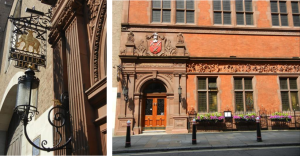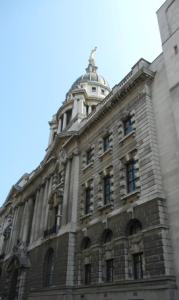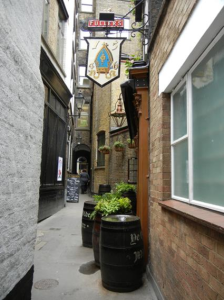The City of London, commonly called “the City,” is London’s main financial and legal district. It is located in an area of the city where the Romans founded the original Londinium trading center in roughly 47 BCE. There are several places in the area where the original Roman walls of the City can be seen, such as just north of the Tower of London, next to the Tower Hill tube station. So it probably is the oldest and most historically interesting part of London. During my recent visit to London I spent about three hours walking around an area close to iconic St. Paul’s Cathedral that took in some quite well-known landmarks such as the “Old Bailey” criminal court and Dr. Johnson’s house, as well as some places that are relatively unknown.
I took the tube (underground train) from the Pimlico station, near my hotel, to the St. Paul’s tube station. I took exit 1 from the St. Paul’s tube station and then turned to the left and walked along St. Martin’s le Grand (Aldersgate Street). I crossed the road until I reached the entrance to Postman’s Park. This is marked by a drinking fountain and an iron fence. I passed through the park entrance and came into a beautiful shaded garden.

The entrance to Postman’s Park; the view from just inside the entrance; and the goldfish pool with fountain.
There is a goldfish pool and fountain just a few steps inside the park. The garden was first opened in 1880 and includes a memorial — the Watts Memorial — to the heroic deeds of “ordinary” people who lost their lives while saving others. The memorial was named after a Victorian artist, George Frederick Watts, who had the idea for the memorial and ensured it was built. The memorial includes the names of 53 men, women and children, and was first unveiled in 1900. The names are set in tiles with ornate floral and architectural designs. One such example that I read was for an 11-year old boy called Solomon Galaman who died while saving his brother from being run over in a street. There are many similar stories enshrined in the wall. Each name in the memorial is accompanied by a brief description of the cause of death of the person being remembered. The memorial has spaces for more tiles but, apparently, only 53 names were added to the wall due to financial constraints. The wall was in a remarkably good condition considering its age.
After looking at the memorial, I took a short walk to the park exit on King Edward Street, turned left and then crossed the road to look at the statue of Rowland Hill, who founded the uniform penny postage in 1840, and is considered to be the inventor of the postage stamp.
I then continued along King Edward Street until I reached the remains of Christchurch Greyfriars church – rebuilt on the site of a Franciscan monastery, which had existed since about 1228, by Christopher Wren and completed in 1707. The church was bombed in December 1940 during the Second World War. What was the interior of the church now looks like a traditional English cottage garden, and was overflowing with pungent blooms.

The remains of Christchurch Blackfriars and garden. With its lamps and iron gateway, the alleyway next to Greyfriars looks very Dickensian.
I walked along the alley at the side of the church and then turned left by the old graveyard – which is now a small park – and walked past the remaining church building to Newgate Street.
I then crossed Newgate Street and turned right until I got to Warwick Lane and turned left. On the right, on the other side of the road I saw the distinctive red-brick building of the Cutlers Hall. The Cutlers Company – or Worshipful Company of Cutlers – dates from 1416 and is one of the old trade guilds (societies) of the City of London. As suggested by their name, the Cutlers were involved in “producing and trading in knives, swords and other implements with a cutting edge” and later became involved in producing medical instruments, according to the guild’s own information on display at the front of the building. More information about the Cutlers can be found on their website at www.cutlerslondon.co.uk.
After passing the Cutlers Hall I turned right into Warwick Square and then descended steps into Warwick Passage, which goes under the Central Criminal Court, known as the Old Bailey. This court is also known as Justice Hall and used to be located next to Newgate Prison, which was demolished in 1904. The original court building dated from 1673 but has been remodeled several times and the current building dates from 1907. After walking through the passageway, I emerged onto Old Bailey street and then turned right and crossed the road so that I could take a picture of the court building. There were lots of police around so there must have been an important trial going on in the court.
I continued along Old Bailey until I reached Newgate Street and then crossed the road to St. Sepulchre-without-Newgate church. On the corner of the churchyard I saw the first drinking fountain installed by the Metropolitan Drinking Fountain and Cattle Trough Association in 1859. A fairly unique feature of the fountain was that it included two metal cups, chained to fence railings, with the words “Replace the Cup” along the bottom of the fountain. I didn’t try the fountain to see whether it is still working. The church is famous for its inclusion in the nursery rhyme “Oranges and Lemons,” in which the bells of the church are described as the “Bells of Old Bailey.” The church also has strong links with the London Regiment (a part-time reserve force of the British army). I looked into the church and there was an orchestra practicing and I saw the regimental colours (flags) hanging from the walls.
After looking around the churchyard, I turned left along Newgate Street, past the church, and continued down along Snow Hill. I passed an old police station that was originally the Saracen’s Head Inn – which features in some of Charles Dickens’ work – and then continued until I reached part of Smithfield Market, an old market where – according to my brother (who is a chef in London) – one can buy good quality meat and fish at very reasonable prices. After a quick look at some of the old market buildings (which I think would be worth a tour one day), I continued to the bottom of Snow Hill and then turned right onto Farringdon Street, and then left onto Charterhouse Street at the traffic lights. This street has a slight incline and near the top I turned right and crossed the road and walked along Ely Place. This is a private road belonging to the Crown and there is a gatekeeper and barrier for traffic – perhaps to let through only residents’ vehicles – at the entrance to road. Pedestrians can walk through the side gate, which is what I did. I walked along this road for a short while and then crossed to the left side to look at St. Etheldreda.
This is an ancient church that dates from 1260. The crypt chapel beneath the main church is the oldest place of Roman Catholic worship in London. Ely Place was once a palace of the Bishops of Ely (a town in East Anglia, to the north east of London). I entered the church, hoping to get a coffee at the church café but unfortunately it was closed and instead I entered the main church congregational area. The church has some beautiful stained glass windows – dating from the 1960s – that depict scenes from the Bible. After spending a few moments in the church I exited through the door by which I had entered and then walked back along Ely Place until I reached a narrow passageway called Ely Court that led to the Olde Mitre pub.
This is a very quaint old building that is hidden away from the surrounding streets. I entered the pub to see if I could get a quick bite to eat. The menu was disappointing because it was rather sparse for my taste; and it included such delicacies as sausage rolls and Scotch eggs. I ordered some cheese and pickle sandwiches (none of that nuvo cuisine stuff here, thank you very much) and a glass of something. It wasn’t a very exciting lunch but it provided some sustenance for the remainder of the walk. The inside of the pub was very “oldy worldy,” with dark wood paneling and furniture, and a small number of tables. Somewhere next to the pub there is supposed to be the stump of an old cherry tree around which Elizabeth I reportedly danced, but I did not notice it.
To see part 2 of my walk, please click here.




No comments yet.